
Prolific app maker ignites low code revolution at Schlumberger
“Microsoft Power Platform provides a low code environment to drive innovation at the edge of our business, enabling us to drive digital transformation at an enterprise level” – Alan Chai, Digital Transformation Leader, Schlumberger
Schlumberger is the world’s largest energy service company. Operating in over 85 countries with 100k+ employees, they describe themselves as a “mini United Nations” of 140 nationalities. With a strong culture of engineering and innovation, Schlumberger firmly believes that technology drives exploration and production performance. For over 90 years, they’ve used innovative technology and reservoir domain expertise to deliver solutions that help improve the performance of customers in the energy industry. Schlumberger’s mission is to use technology to uncover the full potential of energy sustainability.
Over the past eighteen months, Schlumberger has seen rapid viral adoption of the Power Platform, reaching over 10k monthly active users, 650+ production apps and 120+ citizen developers building solutions on the platform across 32 countries. This past summer they ran a Power Platform hackathon, which, in a single week saw 1000+ participants sign up across 47 countries and build ~100 solutions in a week.
Given the scale of adoption and breadth of solutions, we will cover the Schlumberger story in multiple parts. In this post we’ll focus on the solutions built by Alan Chai, who spearheaded the citizen development efforts in a “Digital Cell” at Schlumberger Europe. The Digital Cells are part of a decentralized IT effort, in contrast to “Digital Studios” that reside within a Central IT function. We will highlight how it all got started with a health campaign and an app to motivate Schlumberger employees to live healthier lives. We’ll also describe an Employee Career Progression app which has been used to promote over hundreds of engineers and save over 2000 hours by eliminating paper-based processes, and a Digital Value Calculator solution that is integrated in Microsoft Teams. In a follow up post, we will highlight the progression of the Power Platform into the pro-dev led “Digital Studios”, and the successful efforts within Central IT to create a Center of Excellence around the platform with robust governance, monitor, alerting and security practices.
Watch Schlumberger present their story at the Microsoft Business Applications Summit:
Presentation Video
MEET ALAN
Alan Chai managed a business app development team called “Digital Cell” at Schlumberger Europe. Alan is a self-taught Power Apps maker who places a strong emphasis on user experience and creating Power Apps that look and feel like native apps. You can see this reflected in his stunning portfolio of apps. In a recent #PowerAddicts community hangout, Alan shared his thinking on “User Experience (UX) first” and the difference you can achieve within Power Apps by simply applying a few best practices before putting a solution together. He regularly shares updates on his Power Platform journey on Twitter at @AlanChai

Alan’s team consisted of interns from local universities who underwent two weeks of training on Power Apps, Microsoft Flow and Power BI under the guidance of Alan. They then worked with internal stakeholders and functional heads to enable them on their journey to digital transformation. His team is now using the Power Platform to support the larger corporate transformation program. Alan’s career has evolved as well – he is now Head of Digital Transformation and Innovation, driving transformation in “Digital Cells” at an enterprise level.
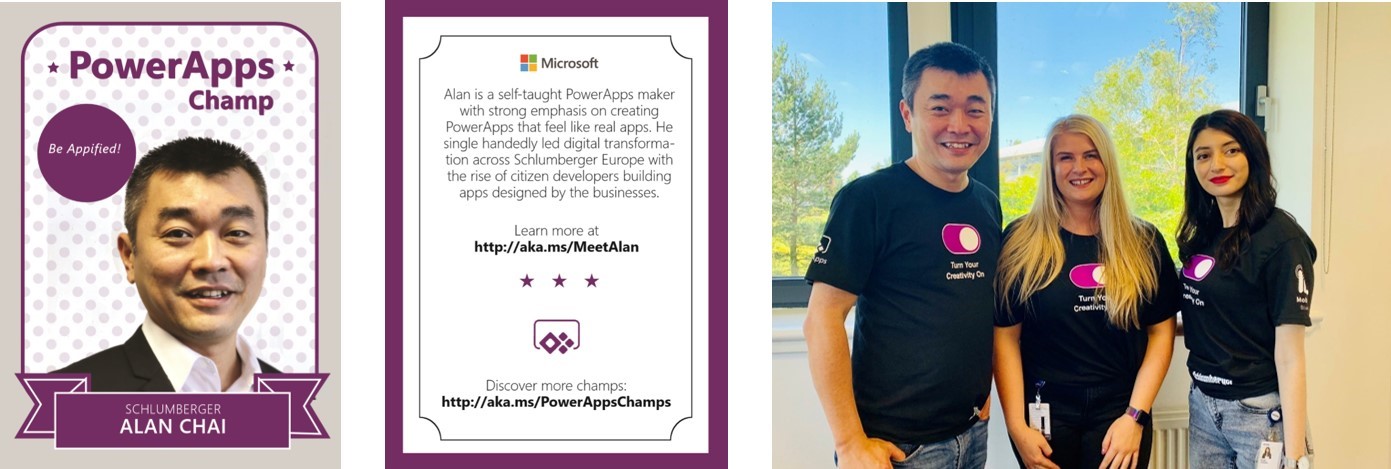
Alan Chai with Power Apps makers at Schlumberger
ACTIVE EUROPE APP
The Schlumberger journey with Power Apps started when Alan saw a need to start a health campaign to encourage work-life balance. Being a first-time user to Power Apps, Alan spent a weekend learning from the Power Apps community and was able to put together a working fitness tracking app by Monday morning – within 2 days! The app was called ActiveEurope. Together with their Europe Health and Safety Director, they launched a campaign to solicit co-workers to log a run around all Schlumberger Europe locations in a circle, which was about 22,000 km in 3 months. The ActiveEurope PowerApp, working together with Yammer, had such a great adoption rate that they achieved the initial target within 2 weeks. The success of this campaign led to the health campaign app being replicated in more than 10 additional business units spanning 60+ countries across all continents.
In addition to tracking fitness related activities, the app includes a leaderboard with badges to incentivize engagement via friendly competition. Employees take photos of their activities and share with their colleagues. They can also post updates on Yammer through the app to further encourage sharing and viral interest in the health campaign.
A Power BI dashboard is used to display cumulative stats for the ActiveEurope campaign, such as – hours logged, breakdown of activity types, spread of participants across different locations, and more.
CORONAVIRUS STAY SAFE APP
For Schlumberger, the global E&P services leader, the health and safety of their employees and contractors is their first priority. Schlumberger’s Health, Safety and Environment (HSE) function came together at the very early stages of the COVID-19 virus outbreak to raise awareness and educate employees on preventative measures. Accordingly, Schlumberger developed a Power Apps solution called “Coronavirus Stay SAFE” to provide timely updates to their highly mobile workforce. The app enabled rapid dissemination of important and relevant information from official health organizations like the WHO, CDC, and company-specific information. The app also provides a single source of truth and a reference for preventive measures to minimize exposure.
Schlumberger maintains a centralized repository of Power Apps components to enable developers to rapidly build and deploy new apps. In this case, the app was conceived and developed within three hours by a Schlumberger HSE team member. In its first week of deployment, the app was recognized by Microsoft as one of the fastest adopted Power Apps in the world. Within one month, the app has been used in over 80 countries and is now available in 10 languages.
CAREER PROMOTION EVALUATION APP (“G11 Mobile”)
Moving on from a social app, the next step was to build something that was closer to the business. Schlumberger has a very structured way in developing their people. One of the most mature HR processes is called GFE Control (General Field Engineer) – employees deliver a project outside their day-to-day work, and demonstrate through a presentation the value the project brings to the company or customers. This process helps employees grow and develop to take on bigger challenges and promotions in their career. They needed a way to digitize the cumbersome paper-based process that was used to evaluate employee projects and presentations.

Before Power Platform – business process, challenges, and opportunities
Prior to the Power Platform solution, each of the ~15 managers in a presentation session used a paper form to provide their assessment of the employee’s performance. The various VPs from different units, e.g. HR, Finance, Legal, etc. interviewed the candidates and provide their summary evaluation in individual blocks on a single paper form. This process led to multiple challenges:
- A single paper form had to be manually transferred from one VP to another.
- As all the data was buried in paper, when there was an opening to fill a Sales Engineering position, there was no convenient way to determine the best candidate across the GFE candidates based on the cumulative feedback. They had to reach into the filing cabinet and start tabulating results manually.
In addition to needing to streamline the business process, Alan considered this a personal challenge to help the environment by reducing or eliminating the need for paper printing as part of this process.
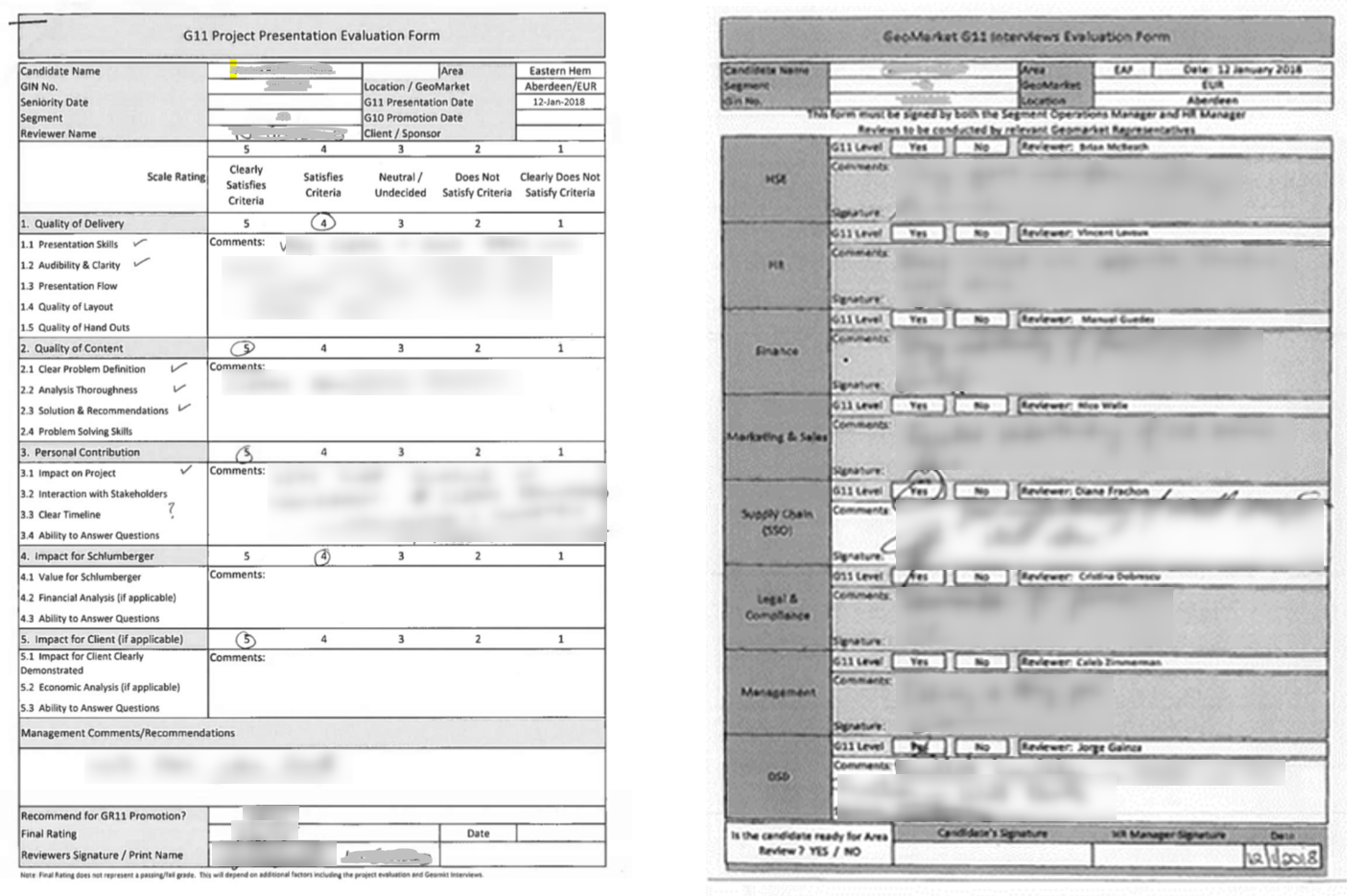
Left: presentation evaluation form filled out by each manager; Right: single feedback form used by multiple VPs
Power Platform solution
The team put together a Power Apps canvas app called “G11 Mobile” with Alan as the primary app maker. The app was built in under a week and has replaced the need for paper printing as all project evaluations and documents are available in a digital app. The app was such a success that it has being reused or replicated over 18 times across multiple business units. After a year in production, it was estimated to give back 2000 hours to the business from efficiency gain and help save 120 trees based on the number of sheets of paper that were no longer printed.
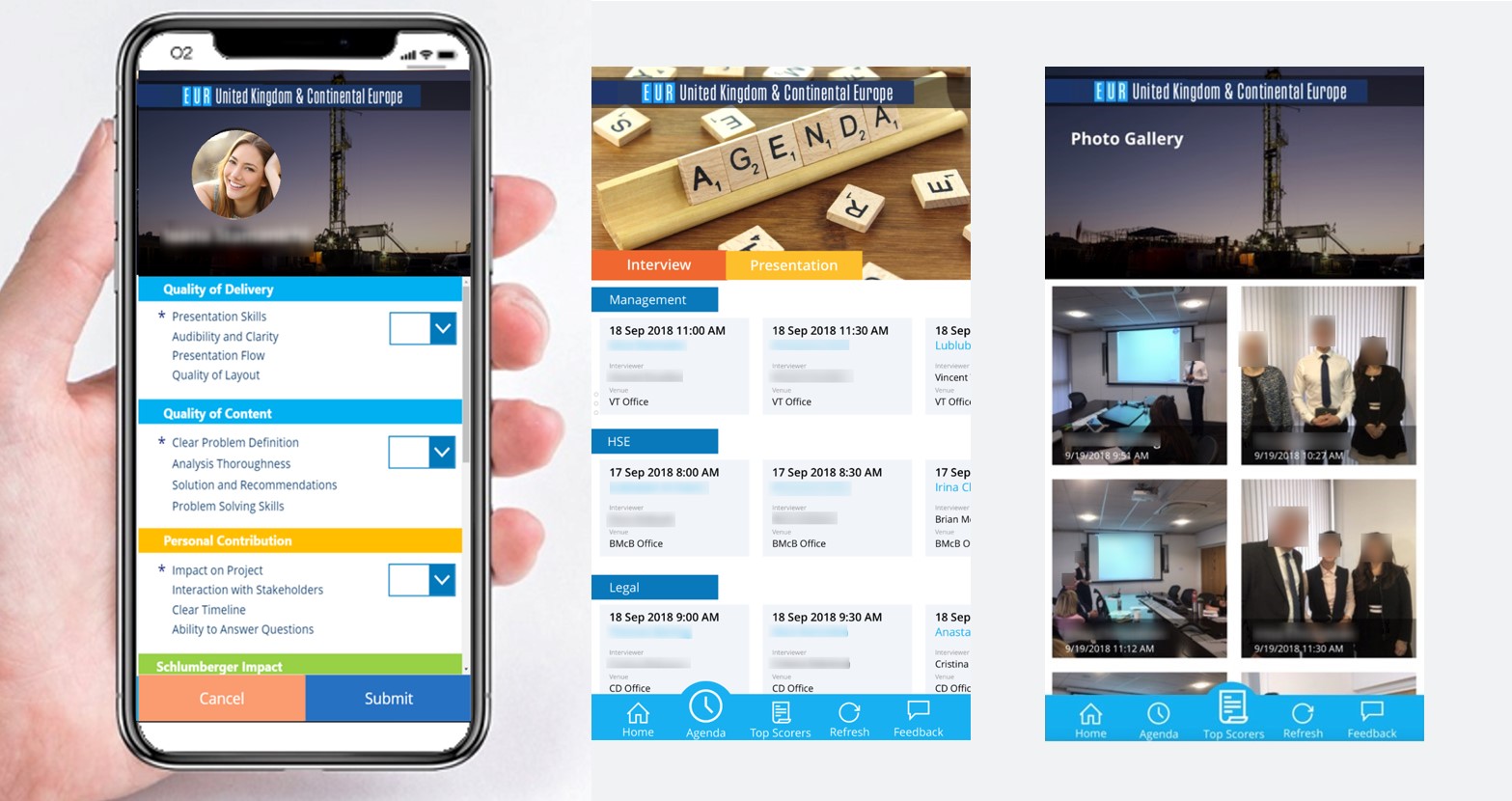
G11 application – used for career promotion evaluations
Let’s look at how the process works. When an engineer is ready to present their project, an HR Training Coordinator registers the candidate in a SharePoint Online list and adds relevant metadata about the candidate and the project. As the various Function Heads interview the candidate, they use the Power Apps on their mobile device to score the candidate and add their notes. On the presentation day, all managers use the “Presentation” option to score each candidate using a form in Power Apps that matches the layout of the paper form. Some of the key features of the application include:
- Integrated camera functionality to capture photos during presentation events
- Access control based on user type – candidate / manager / function head / app owner
- Agenda/scheduling for showing the sequence of interviews and presentation for each candidate
- Photo gallery to display all photos for a candidate
Benefits and Impact
The app was deployed in July 2018 and has been running in production for fourteen months. A few key benefits include:
- Been used to promote over 450 engineers across the world
- Saved over 2,000 hours of time that was previously spent in manual paper processes
- The HR Training Coordinator used to spend at least 3 to 4 days post-event to find the overall scores for all candidates through an Excel file. This is now computed instantly based on criteria set by the G11 process.
- The app has elevated employee engagement based on the visible recognition of their contributions in their G11 project.
This app marked the beginning of the digital journey with the Power Platform and subsequently led to evolving many other internal processes to achieve efficiency gains, cost avoidance and ultimately generate business impact which aligned with corporate objectives.

DIGITAL VALUE CALCULATOR – USED WITHIN MICROSOFT TEAMS
Schlumberger has a high focus on ensuring that resources are being prioritized based on value creation, and correspondingly, solutions that do not generate direct business value get de-prioritized. They created a Digital Value Calculator to measure and track the value of their Power Platform solutions. This app has been used by managers of “Digital Cells” to measure the impact of over 60 solutions across twenty global regions.
Some of the key dimensions used to measure impact are:
- Efficiency gained – how many hours have been given back to the business after the solution was deployed.
- Business impact – how much free cash flow or ‘income before tax’ was generated from a given solution.
- Savings in implementation costs – how much have they saved by building a solution in-house with rapid development approaches compared to purchasing a 3rd party solution.
Managers access the PowerApp and the Power BI dashboards primarily from within Microsoft Teams.
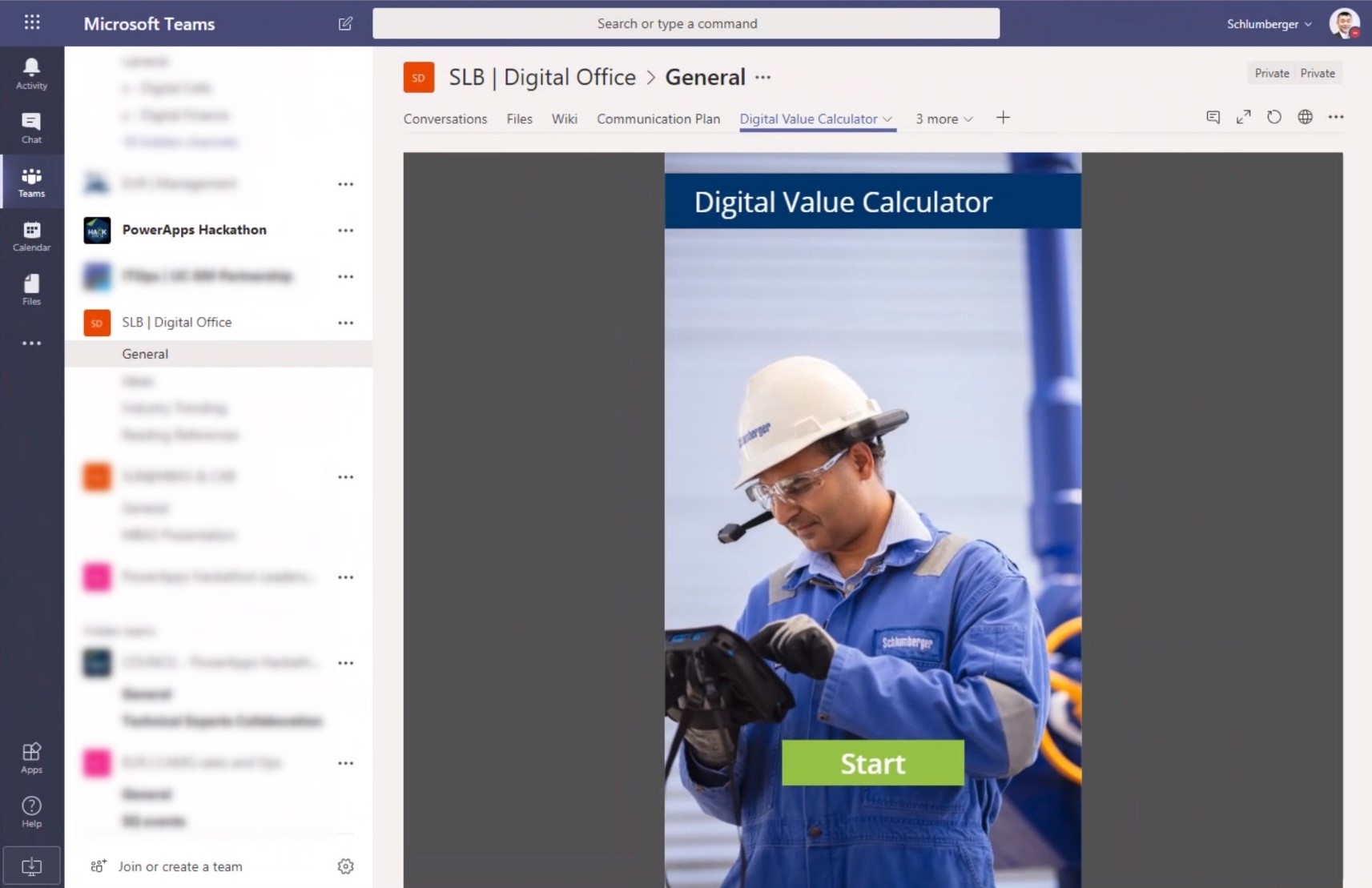
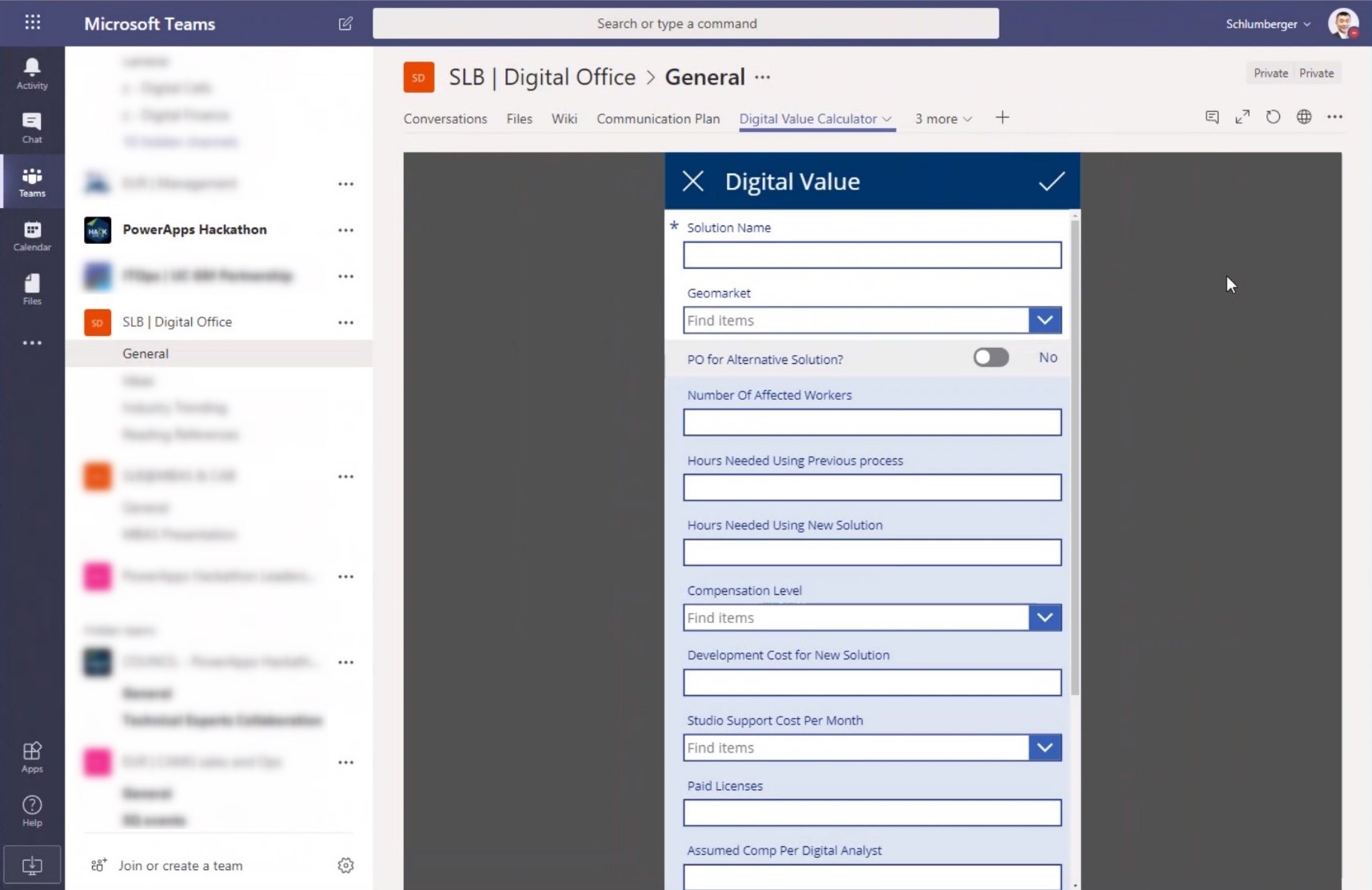
SOLUTION ARCHITECTURE
A consistent architecture pattern across Alan’s app includes Power Apps canvas apps that connect to data stored in SharePoint Online lists, with Microsoft Flow and Power BI used by some of them for automation and reporting, respectively. In addition, some apps connect to services such as Yammer or run embedded within Microsoft Teams. Alan has created a library of template apps with branding and basic design patterns in place, which allows him to create and publish new apps rapidly, sometimes within a couple hours.
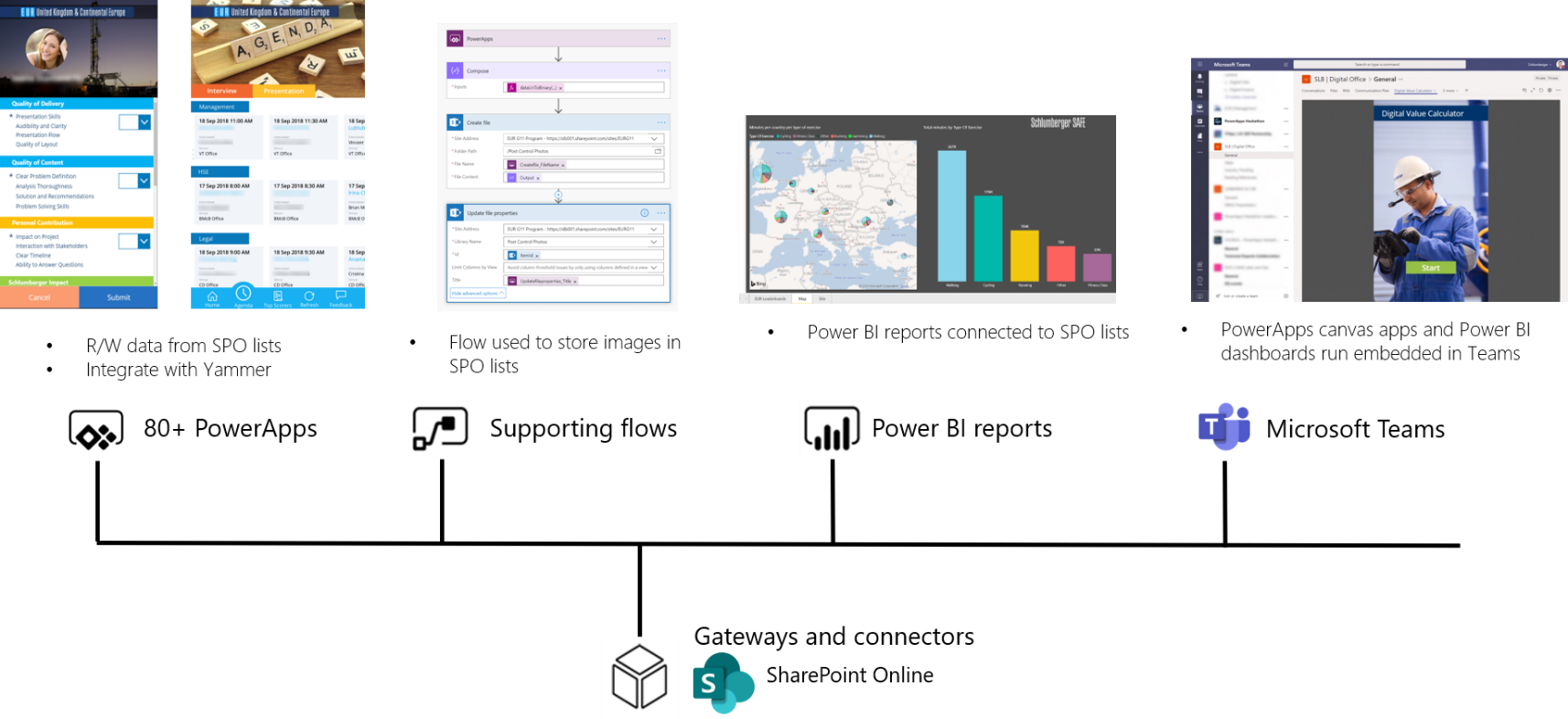
ADDITIONAL APPS
Here are a few additional examples from the 80+ apps built by Alan and his team at Schlumberger:
WHATSUP
A PowerApp solution that crowd sources input from Operations Managers to track employees moving within different roles in the field. It allows employees to send congratulatory notes and say goodbye in a casual way. It also serves as a single point to view the history of organizational changes without having to go through a list of Yammer posts. The employee data is managed and validated by HR prior to going public using a built-in approval process within the app.


APPRAISAL APP
A performance management app that is used by the executive team at Schlumberger to perform performance evaluations while on the road.
ON DEMAND VIDEO PORTAL
A portal to push video content to field employees who are often hard to reach. The content is structured and targeted based on roles in the organization. This is also used as self-service digital signage around the campus.
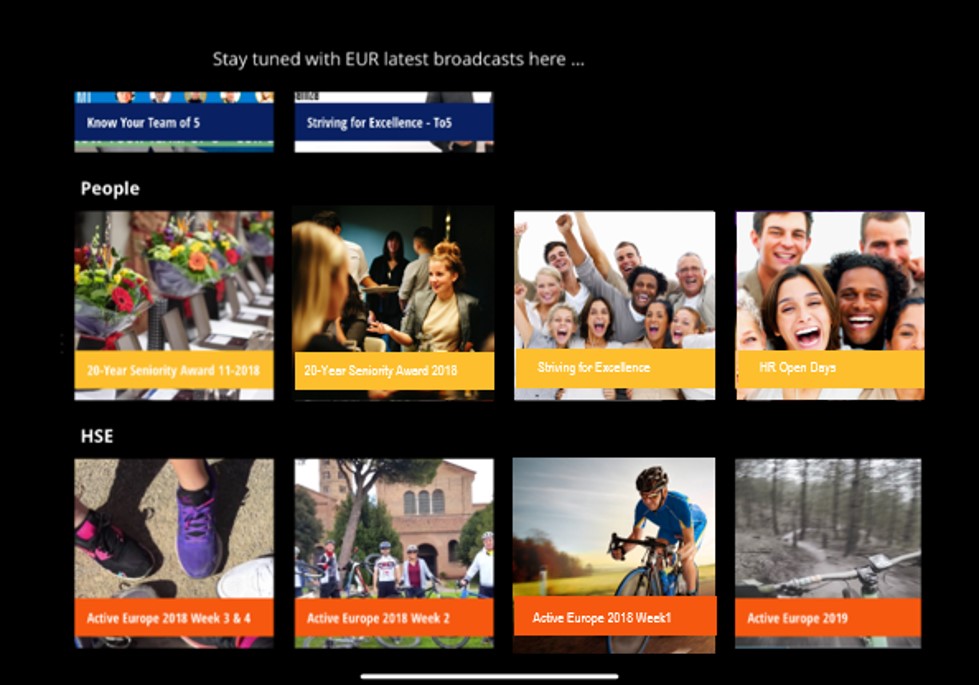
LOOKING AHEAD
Alan has played a transformational role in igniting the low code revolution at Schlumberger. Along with Alan, there are several citizen developers in Digital Cells globally across Schlumberger rapidly creating cross platform solutions to digitize business processes. As the adoption, visibility and business value of the Power Platform grew, it caught the attention of the centralized Digital Studios IT team consisting of .NET and Xamarin developers. Ladd Laird, Director of Mobility Studio, who leads a team of full stack developers described it as “IT waking up” – his team woke up to the pace at which the decentralized Digital Cells were able to deliver on solutions using a low code platform.
Meanwhile, with hundreds of apps and thousands of monthly users across Schlumberger, Ken Auguillard who is IT Operations Manager at Schlumberger realized he needed to establish robust governance processes without stifling innovation. In a future post we’ll dive into further details on the adoption of the Power Platform by Ladd’s team along with the work by Ken Auguillard and his central IT team to establish a Power Platform Center of Excellence (COE) with the necessary security, monitoring and alerting processes, while continuing to empower the engineers at Schlumberger to rapidly innovate with the Power Platform. To hear this story directly from Alan and Ladd, watch their customer story presentation at the Microsoft Business Application Summit held in June 2019.

From left: Ladd Laird (Director, Mobility Enterprise Studio), Alan Chai (Head of Digital Transformation & Innovation), Kenric Auguillard (Core Productivity Platform Manager)
RELATED LINKS
- Alan Chai’s presentation at MBAS 2020 – presentation
- Schlumberger presentation at Ignite 2019 – Ladd Laird talks about COE (27 min mark)
- Schlumberger presentation at MBAS 2019 – presentation



